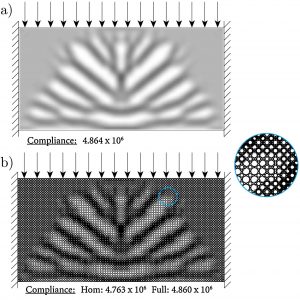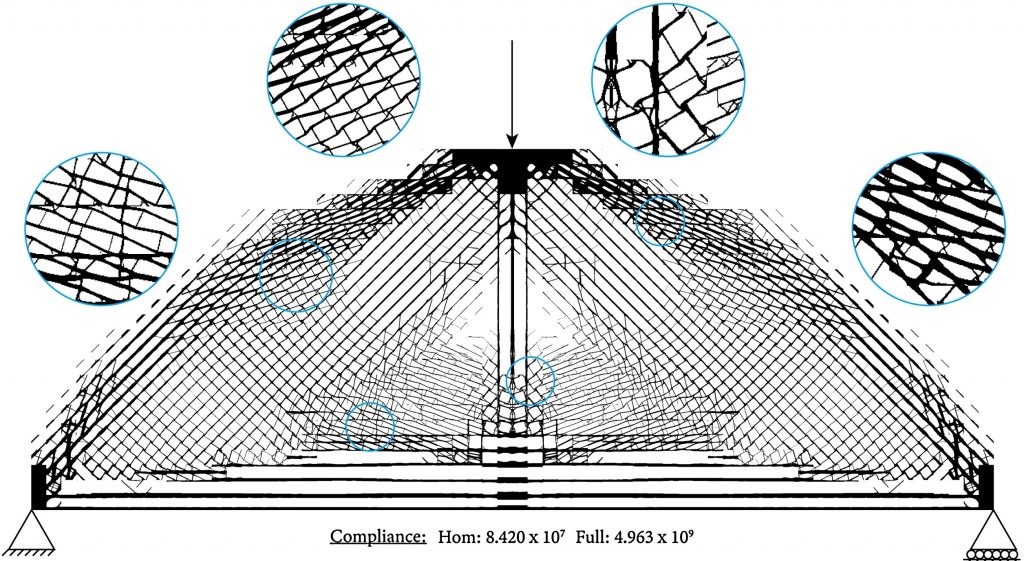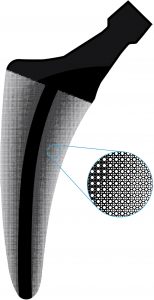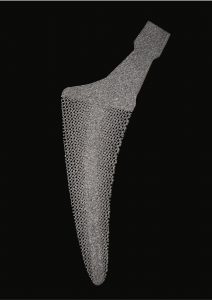Trabecular bone, also known as spongy or cancellous bone, is one of two types of bone found in the human body. It is found at the end of long bones, in the pelvic bones, ribs, skull and vertebrae. Trabecular bone is one of many microstructures with spatially varying properties found in nature. In a paper entitled “Compatibility in microstructural optimization for additive manufacturing,” a group of researchers points out that these microstructures can now be created by additive manufacturing. One challenge in the computational design of such materials is ensuring compatibility between adjacent microstructures. The researchers’ work aims to find the optimal connectivity between topology optimized microstructures.
“Given the fact that the optimality of connectivity can be evaluated by the resulting physical properties of the assemblies, we propose to consider the assembly of adjacent cells together with the optimization of individual cells,” the researchers explain. “In particular, our method simultaneously optimizes the physical properties of the individual cells as well as those of neighbouring pairs, to ensure material connectivity and smoothly varying physical properties. This idea is substantiated on the design of graded microstructures with maximized bulk moduli under varying volume fractions. The graded microstructures are employed in designing an implant, which is fabricated by additive manufacturing.”
When designing orthopedic implants, the researchers point out, it “may be desirable to have a continuous transition from denser microstructures in the central region to highly porous microstructures at the bone-implant interface.” This functional gradation promotes bony ingrowth at the bone-implant interface, they continue, while maintaining structural integrity and increasing mechanical properties in areas where bony ingrowth is not relevant.
The researchers presented a method of ensuring mechanical compatibility among topology optimized microstructures.
“Our results show that the bulk moduli of individual cells reach the theoretical bounds predicted by the Hashin–Shtrikman model, meaning that the optimization of compatibility does not compromise the performance of individual cells,” they state. “Furthermore, the bulk moduli of neighbouring pairs also agree well with the Hashin–Shtrikman bounds.”
 The method was extended to allow maximum length scale and isotropy in microstructures. The researchers demonstrated the effectiveness of their proposed method in a number of designs, including functionally graded materials and multiscale structures. They also showed that the optimized microstructures can be fabricated by additive manufacturing technology. This has implications for a number of applications, including orthopedic implants, which 3D printing can optimize for better growth of new bone.
The method was extended to allow maximum length scale and isotropy in microstructures. The researchers demonstrated the effectiveness of their proposed method in a number of designs, including functionally graded materials and multiscale structures. They also showed that the optimized microstructures can be fabricated by additive manufacturing technology. This has implications for a number of applications, including orthopedic implants, which 3D printing can optimize for better growth of new bone.
“As future work, we are particularly interested in the following aspects,” the researchers conclude. “Firstly, this method is directly applicable to 3D design problems. To alleviate the computational burden in 3D, the GPU-based topology optimization framework can be used. Secondly, while we have applied the compound formulation for maximizing bulk modulus, its applicability to other physical problems such as conductivity is left to be demonstrated.”
Authors of the paper include Eric Garner, Helena M.A. Kulken, Charlie C.L. Wang, Amir A. Zadpoor and Jun Wu.
Discuss this and other 3D printing topics at 3DPrintBoard.com or share your thoughts below.
Subscribe to Our Email Newsletter
Stay up-to-date on all the latest news from the 3D printing industry and receive information and offers from third party vendors.
You May Also Like
Profiling a Construction 3D Printing Pioneer: US Army Corps of Engineers’ Megan Kreiger
The world of construction 3D printing is still so new that the true experts can probably be counted on two hands. Among them is Megan Kreiger, Portfolio Manager of Additive...
US Army Corps of Engineers Taps Lincoln Electric & Eaton for Largest 3D Printed US Civil Works Part
The Soo Locks sit on the US-Canadian border, enabling maritime travel between Lake Superior and Lake Huron, from which ships can reach the rest of the Great Lakes. Crafts carrying...
Construction 3D Printing CEO Reflects on Being Female in Construction
Natalie Wadley, CEO of ChangeMaker3D, could hear the words of her daughter sitting next to her resounding in her head. “Mum, MUM, you’ve won!” Wadley had just won the prestigious...
1Print to Commercialize 3D Printed Coastal Resilience Solutions
1Print, a company that specializes in deploying additive construction (AC) for infrastructure projects, has entered an agreement with the University of Miami (UM) to accelerate commercialization of the SEAHIVE shoreline...
































